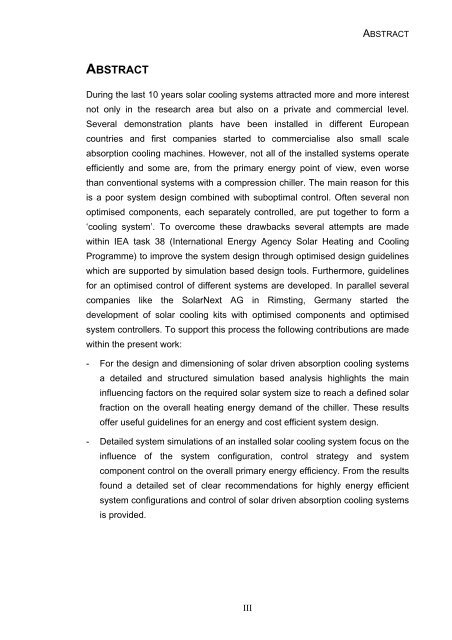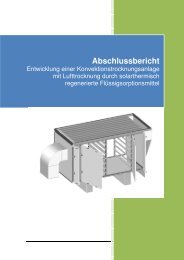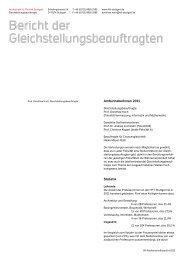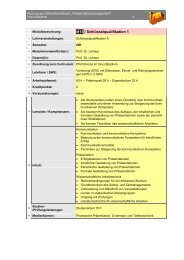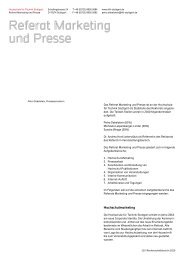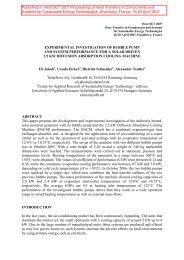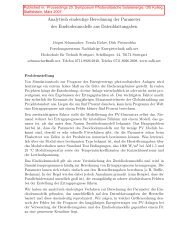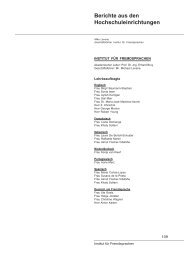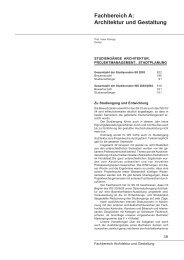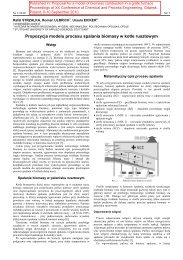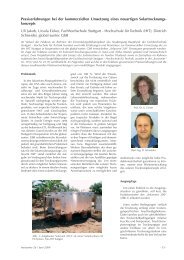- Page 1: MODEL BASED CONTROL OPTIMISATION OF
- Page 5 and 6: DECLARATION V DECLARATION The resea
- Page 7 and 8: VII ACKNOWLEDGEMENTS
- Page 9 and 10: IX TABLE OF CONTENT 3.4 COMPONENT A
- Page 11 and 12: XI TABLE OF CONTENT 5.4.7 CONVENTIO
- Page 13 and 14: APPENDIX XIII TABLE OF CONTENT APPE
- Page 15 and 16: XV NOMENCLATURE PEF [-] Primary ene
- Page 17 and 18: e evaporator el electrical ev evapo
- Page 19 and 20: 1. INTRODUCTION Page - 1 - CHAPTER
- Page 21 and 22: Page - 3 - CHAPTER 01 fans and pump
- Page 23 and 24: Page - 5 - CHAPTER 01 the implement
- Page 25 and 26: Page - 7 - CHAPTER 01 lower. The th
- Page 27 and 28: Page - 9 - CHAPTER 01 dry ambient a
- Page 29 and 30: Page - 11 - CHAPTER 01 For purely s
- Page 31 and 32: Page - 13 - CHAPTER 02 does not pro
- Page 33 and 34: Page - 15 - CHAPTER 02 simulation b
- Page 35 and 36: ( T −T ) ( T −T ) col , m t amb
- Page 37 and 38: this differential equation has the
- Page 39 and 40: Page - 21 - CHAPTER 02 Since neithe
- Page 41 and 42: s m sc s h , col , i h , ad , i loa
- Page 43 and 44: Page - 25 - CHAPTER 02 to ensure as
- Page 45 and 46: Page - 27 - CHAPTER 02 Two differen
- Page 47 and 48: T tube, i ( t ) = T tube, i + T ⎛
- Page 49 and 50: 2.2.2 COOLING SYSTEM 2.2.2.1 Static
- Page 51 and 52: Page - 33 - CHAPTER 02 heated up an
- Page 53 and 54:
Page - 35 - CHAPTER 02 Since the so
- Page 55 and 56:
h h ( Tc t c ) UAc m& V ( h h ) Q&
- Page 57 and 58:
−1 Page - 39 - CHAPTER 02 ⎡⎛
- Page 59 and 60:
Cooling power Qe [kW] 20 18 16 14 1
- Page 61 and 62:
Page - 43 - CHAPTER 02 With these p
- Page 63 and 64:
m& g a = m& = m& = c m& = e c c c c
- Page 65 and 66:
Cooling water outlet Hot water inle
- Page 67 and 68:
- Evaporator & Qa _ e Tac ( t −1)
- Page 69 and 70:
Page - 51 - CHAPTER 02 performance
- Page 71 and 72:
a) Model development - Fundamentals
- Page 73 and 74:
Fig. 2-18: Water cooling in an idea
- Page 75 and 76:
m& l min = m& m& a l 0 = m& w l 0
- Page 77 and 78:
Page - 59 - CHAPTER 02 However, oft
- Page 79 and 80:
Page - 61 - CHAPTER 02 This proport
- Page 81 and 82:
Page - 63 - CHAPTER 02 The water co
- Page 83 and 84:
Recooling power [kW] 50 45 40 35 30
- Page 85 and 86:
Table 5: Technical data of the GFH0
- Page 87 and 88:
T fluid Page - 69 - CHAPTER 02 ⎛
- Page 89 and 90:
2.3.1 SOLID DEHUMIDIFICATION SYSTEM
- Page 91 and 92:
2.3.2 HEAT EXCHANGERS Page - 73 - C
- Page 93 and 94:
Page - 75 - CHAPTER 02 The mass of
- Page 95 and 96:
Page - 77 - CHAPTER 02 - Considerat
- Page 97 and 98:
Page - 79 - CHAPTER 02 offered for
- Page 99 and 100:
( t − 1 ) + T ( t ) T , ( t ) T ,
- Page 101 and 102:
- Temperature of the back cover ⎛
- Page 103 and 104:
Page - 85 - CHAPTER 03 3. DIMENSION
- Page 105 and 106:
Page - 87 - CHAPTER 03 values of am
- Page 107 and 108:
Page - 89 - CHAPTER 03 In addition,
- Page 109 and 110:
Fig. 3-3: Office building dominated
- Page 111 and 112:
Page - 93 - CHAPTER 03 the solution
- Page 113 and 114:
Page - 95 - CHAPTER 03 were availab
- Page 115 and 116:
Page - 97 - CHAPTER 03 constant slo
- Page 117 and 118:
3.5 SYSTEM SIMULATION RESULTS Page
- Page 119 and 120:
Page - 101 - CHAPTER 03 Fig. 3-11:
- Page 121 and 122:
Page - 103 - CHAPTER 03 between 511
- Page 123 and 124:
Page - 105 - CHAPTER 03 32°C the e
- Page 125 and 126:
Page - 107 - CHAPTER 03 For the loc
- Page 127 and 128:
Page - 109 - CHAPTER 03 basic inter
- Page 129 and 130:
Collector costs / Euro m - ² 1200
- Page 131 and 132:
Page - 113 - CHAPTER 03 Fig. 3-24:
- Page 133 and 134:
Page - 115 - CHAPTER 03 The total c
- Page 135 and 136:
Page - 117 - CHAPTER 03 levels cann
- Page 137 and 138:
Page - 119 - CHAPTER 04 control str
- Page 139 and 140:
Page - 121 - CHAPTER 04 18°C retur
- Page 141 and 142:
Page - 123 - CHAPTER 04 Table 4-1:
- Page 143 and 144:
4.3.3 GENERAL DISCUSSION OF POSSIBL
- Page 145 and 146:
Page - 127 - CHAPTER 04 conditions.
- Page 147 and 148:
Page - 129 - CHAPTER 04 4.4 ANALYSI
- Page 149 and 150:
Page - 131 - CHAPTER 04 Measurement
- Page 151 and 152:
4.4.3 Analysed Control Strategies P
- Page 153 and 154:
Page - 135 - CHAPTER 04 of the hot
- Page 155 and 156:
Page - 137 - CHAPTER 04 due to the
- Page 157 and 158:
Page - 139 - CHAPTER 04 avoided com
- Page 159 and 160:
Page - 141 - CHAPTER 04 single effe
- Page 161 and 162:
Page - 143 - CHAPTER 04 Therefore,
- Page 163 and 164:
Page - 145 - CHAPTER 04 try to redu
- Page 165 and 166:
Page - 147 - CHAPTER 04 Fig. 4-12:
- Page 167 and 168:
4.5.3 CONTROL CODE DEVELOPMENT AND
- Page 169 and 170:
Table 4-5: Analysed typical hot sum
- Page 171 and 172:
Page - 153 - CHAPTER 04 above 65°C
- Page 173 and 174:
Page - 155 - CHAPTER 04 water at ge
- Page 175 and 176:
Page - 157 - CHAPTER 04 charged aga
- Page 177 and 178:
Page - 159 - CHAPTER 04 - Case 4: P
- Page 179 and 180:
4.5.5.2 DAILY SIMULATION RESULTS Pa
- Page 181 and 182:
Table 4-6: Overview of main results
- Page 183 and 184:
Table 4-8: Results related to ACM o
- Page 185 and 186:
Page - 167 - CHAPTER 04 (some cloud
- Page 187 and 188:
Page - 169 - CHAPTER 04 temperature
- Page 189 and 190:
Page - 171 - CHAPTER 05 lower regen
- Page 191 and 192:
Page - 173 - CHAPTER 05 Furthermore
- Page 193 and 194:
Page - 175 - CHAPTER 05 The liquid
- Page 195 and 196:
Table 5-3: Technical Data of the va
- Page 197 and 198:
Page - 179 - CHAPTER 05 Fig. 5-3: S
- Page 199 and 200:
Page - 181 - CHAPTER 05 rooms offer
- Page 201 and 202:
Page - 183 - CHAPTER 05 The minimum
- Page 203 and 204:
5.4 SIMULATION MODELS AND VALIDATIO
- Page 205 and 206:
Page - 187 - CHAPTER 05 component b
- Page 207 and 208:
Page - 189 - CHAPTER 05 As visible
- Page 209 and 210:
Page - 191 - CHAPTER 05 considered
- Page 211 and 212:
Relative humidity / Error / % 120 1
- Page 213 and 214:
Page - 195 - CHAPTER 05 Fig. 5-16:
- Page 215 and 216:
Page - 197 - CHAPTER 05 For the pre
- Page 217 and 218:
Page - 199 - CHAPTER 05 collector f
- Page 219 and 220:
Page - 201 - CHAPTER 05 considered
- Page 221 and 222:
Temperature / °C / Error / % 60 50
- Page 223 and 224:
Fig. 5-24: Schematic diagram of the
- Page 225 and 226:
5.5 SENSITIVITY ANALYSIS OF CONTROL
- Page 227 and 228:
Page - 209 - CHAPTER 05 Another fun
- Page 229 and 230:
Page - 211 - CHAPTER 05 above 26.5
- Page 231 and 232:
Page - 213 - CHAPTER 05 K p = 0 . 6
- Page 233 and 234:
Page - 215 - CHAPTER 05 12). The na
- Page 235 and 236:
Page - 217 - CHAPTER 05 If the ambi
- Page 237 and 238:
Primary Energy Optimiser X amb ≤
- Page 239 and 240:
Air humidification Δx / g kg -1 5
- Page 241 and 242:
Page - 223 - CHAPTER 05 this case a
- Page 243 and 244:
Page - 225 - CHAPTER 05 Case 2: Ele
- Page 245 and 246:
5.8 SIMULATION RESULTS AND DISCUSSI
- Page 247 and 248:
Page - 229 - CHAPTER 05 the electri
- Page 249 and 250:
Page - 231 - CHAPTER 05 The advance
- Page 251 and 252:
Page - 233 - CHAPTER 05 times in hu
- Page 253 and 254:
Page - 235 - CHAPTER 05 could be re
- Page 255 and 256:
Page - 237 - CHAPTER 05 Fig. 5-44:
- Page 257 and 258:
Page - 239 - CHAPTER 05 Fig. 5-45:
- Page 259 and 260:
Page - 241 - CHAPTER 05 Fig. 5-46:
- Page 261 and 262:
Page - 243 - CHAPTER 05 temperature
- Page 263 and 264:
Page - 245 - CHAPTER 05 are only ve
- Page 265 and 266:
5.8.4 FURTHER OPTIMISATION POTENTIA
- Page 267 and 268:
Page - 249 - CHAPTER 05 flow contro
- Page 269 and 270:
6. SUMMARY Page - 251 - CHAPTER 06
- Page 271 and 272:
Page - 253 - CHAPTER 06 than with t
- Page 273 and 274:
Page - 255 - CHAPTER 06 value of 13
- Page 275 and 276:
Page - 257 - CHAPTER 06 conditions,
- Page 277 and 278:
Page - 259 - CHAPTER 06
- Page 279 and 280:
Page - 261 - CHAPTER 07 For a relia
- Page 281 and 282:
Page - 263 - CHAPTER 07 improved co
- Page 283 and 284:
Page - 265 - CHAPTER 07 - DEC syste
- Page 285 and 286:
Page - 267 - CHAPTER 07 If such a b
- Page 287 and 288:
Page - 269 - REFERENCES Ginestet, S
- Page 289 and 290:
Page - 271 - REFERENCES Wardono, B.
- Page 291 and 292:
Page - 273 - OWN PUBLICATIONS [12]
- Page 293 and 294:
C E E ⋅ s E E ⋅ ( ΔΔt − Δ
- Page 295 and 296:
APPENDIX A: MODEL DEVELOPMENT Page
- Page 297 and 298:
1.2.2 PROPERTIES OF AQUEOUS LIBR SO
- Page 299 and 300:
1.3 DYNAMIC PART OF THE ACM MODEL P
- Page 301 and 302:
APPENDIX A: MODEL DEVELOPMENT Page
- Page 303 and 304:
B) Evaporator & Qa _ e Q & Q & hl ,
- Page 305 and 306:
APPENDIX A: MODEL DEVELOPMENT Page
- Page 307 and 308:
APPENDIX A: MODEL DEVELOPMENT Page
- Page 309 and 310:
Page - 291 - APPENDIX A: MODEL DEVE
- Page 311 and 312:
- Heat transfer coefficient Absorbe
- Page 313 and 314:
t w,out [°C] Water consumption [kg
- Page 315 and 316:
Recooling power [kW] Water outlet t
- Page 317 and 318:
APPENDIX B: SOLAR COOLING SYSTEM DE
- Page 319 and 320:
APPENDIX B: SOLAR COOLING SYSTEM Sc
- Page 321 and 322:
APPENDIX B: SOLAR COOLING SYSTEM 6.
- Page 323 and 324:
) Hot Water Storage Tank APPENDIX B
- Page 325 and 326:
APPENDIX C: OPTIMISED CONTROL SEQUE
- Page 327 and 328:
APPENDIX C: OPTIMISED CONTROL SEQUE
- Page 329 and 330:
APPENDIX D: DETAILED SIMULATION RES
- Page 331 and 332:
APPENDIX D: DETAILED SIMULATION RES
- Page 333 and 334:
APPENDIX D: DETAILED SIMULATION RES
- Page 335 and 336:
APPENDIX E: SIEMENS BPS CONTROL UNI
- Page 337:
APPENDIX E: SIEMENS BPS CONTROL UNI


